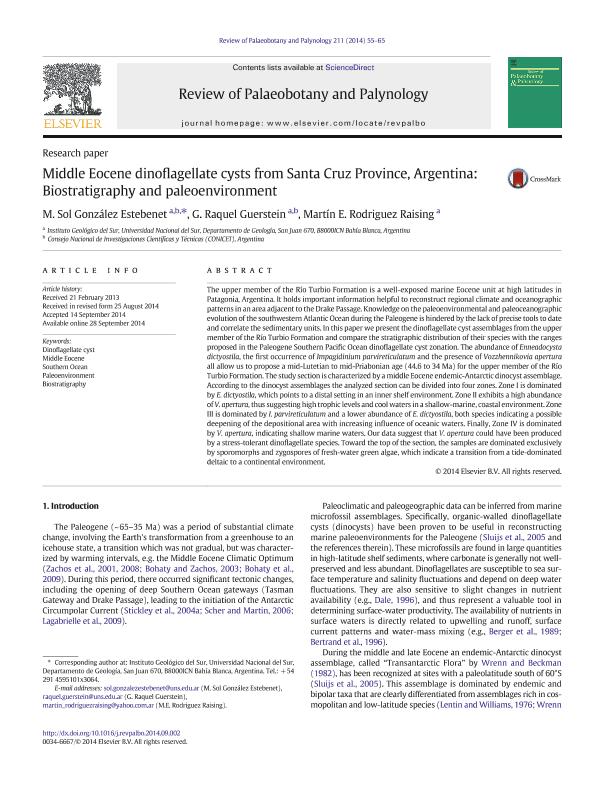Mostrar el registro sencillo del ítem
dc.contributor.author
González Estebenet, María Sol

dc.contributor.author
Guerstein, Gladys Raquel

dc.contributor.author
Rodriguez Raising, Martin Eduardo

dc.date.available
2016-07-19T20:02:58Z
dc.date.issued
2014-09
dc.identifier.citation
González Estebenet, María Sol; Guerstein, Gladys Raquel; Rodriguez Raising, Martin Eduardo; Middle Eocene Dinoflagellate cysts from Santa Cruz Providence, Argentina: Biostratigraphy and Paleoenvironment; Elsevier; Review of Palaeobotany and Palynology; 211; 9-2014; 55-65
dc.identifier.issn
0034-6667
dc.identifier.uri
http://hdl.handle.net/11336/6610
dc.description.abstract
The upper member of the Río Turbio Formation is a well-exposed marine Eocene unit at high latitudes in Patagonia, Argentina. It holds important information helpful to reconstruct regional climate and oceanographic patterns in an area adjacent to the Drake Passage. Knowledge on the paleoenvironmental and paleoceanographic evolution of the southwestern Atlantic Ocean during the Paleogene is hindered by the lack of precise tools to date and correlate the sedimentary units. In this paperwe present the dinoflagellate cyst assemblages fromthe upper member of the Río Turbio Formation and compare the stratigraphic distribution of their species with the ranges proposed in the Paleogene Southern Pacific Ocean dinoflagellate cyst zonation. The abundance of Enneadocysta dictyostila, the first occurrence of Impagidinium parvireticulatum and the presence of Vozzhennikovia apertura all allow us to propose a mid-Lutetian to mid-Priabonian age (44.6 to 34 Ma) for the upper member of the Río Turbio Formation. The study section is characterized by amiddle Eocene endemic-Antarctic dinocyst assemblage. According to the dinocyst assemblages the analyzed section can be divided into four zones. Zone I is dominated by E. dictyostila, which points to a distal setting in an inner shelf environment. Zone II exhibits a high abundance of V. apertura, thus suggesting high trophic levels and coolwaters in a shallow-marine, coastal environment. Zone III is dominated by I. parvireticulatum and a lower abundance of E. dictyostila, both species indicating a possible deepening of the depositional area with increasing influence of oceanic waters. Finally, Zone IV is dominated by V. apertura, indicating shallow marine waters. Our data suggest that V. apertura could have been produced by a stress-tolerant dinoflagellate species. Toward the top of the section, the samples are dominated exclusively by sporomorphs and zygospores of fresh-water green algae, which indicate a transition from a tide-dominated deltaic to a continental environment.
dc.format
application/pdf
dc.language.iso
eng
dc.publisher
Elsevier

dc.rights
info:eu-repo/semantics/openAccess
dc.rights.uri
https://creativecommons.org/licenses/by-nc-nd/2.5/ar/
dc.subject
Dinoflagellate Cysts
dc.subject
Middle Eocene
dc.subject
Southern Ocean
dc.subject
Bioestratigraphy
dc.subject
Paleoenvironment
dc.subject.classification
Paleontología

dc.subject.classification
Ciencias de la Tierra y relacionadas con el Medio Ambiente

dc.subject.classification
CIENCIAS NATURALES Y EXACTAS

dc.title
Middle Eocene Dinoflagellate cysts from Santa Cruz Providence, Argentina: Biostratigraphy and Paleoenvironment
dc.type
info:eu-repo/semantics/article
dc.type
info:ar-repo/semantics/artículo
dc.type
info:eu-repo/semantics/publishedVersion
dc.date.updated
2016-07-12T15:22:27Z
dc.journal.volume
211
dc.journal.pagination
55-65
dc.journal.pais
Países Bajos

dc.journal.ciudad
Amsterdam
dc.description.fil
Fil: González Estebenet, María Sol. Consejo Nacional de Investigaciones Científicas y Técnicas. Centro Científico Tecnológico Bahía Blanca. Instituto Geológico del Sur; Argentina. Universidad Nacional del Sur; Argentina
dc.description.fil
Fil: Guerstein, Gladys Raquel. Consejo Nacional de Investigaciones Científicas y Técnicas. Centro Científico Tecnológico Bahía Blanca. Instituto Geológico del Sur; Argentina. Universidad Nacional del Sur; Argentina
dc.description.fil
Fil: Rodriguez Raising, Martin Eduardo. Consejo Nacional de Investigaciones Científicas y Técnicas. Centro Científico Tecnológico Bahía Blanca. Instituto Geológico del Sur; Argentina
dc.journal.title
Review of Palaeobotany and Palynology

dc.relation.alternativeid
info:eu-repo/semantics/altIdentifier/doi/10.1016/j.revpalbo.2014.09.002
dc.relation.alternativeid
info:eu-repo/semantics/altIdentifier/doi/http://dx.doi.org/10.1016/j.revpalbo.2014.09.002
dc.relation.alternativeid
info:eu-repo/semantics/altIdentifier/url/http://www.sciencedirect.com/science/article/pii/S0034666714001389
Archivos asociados
